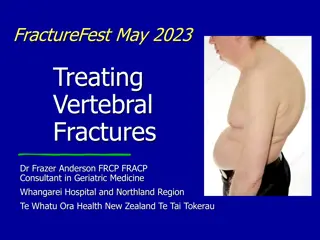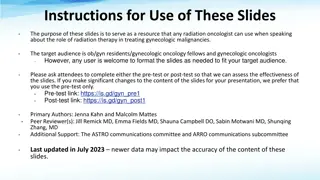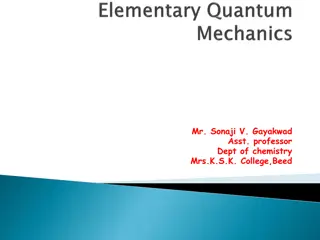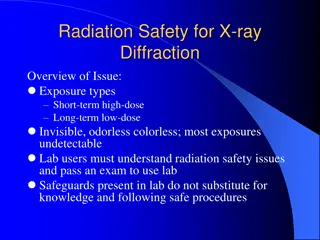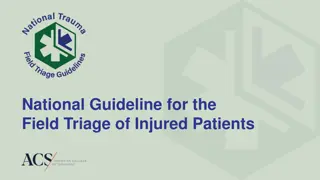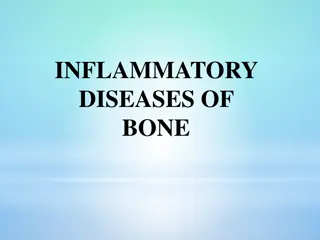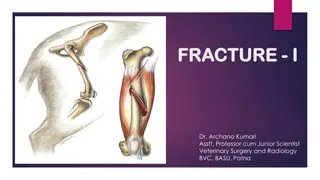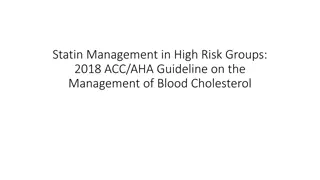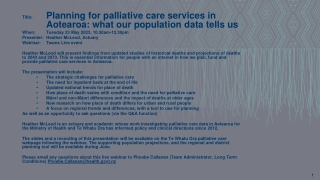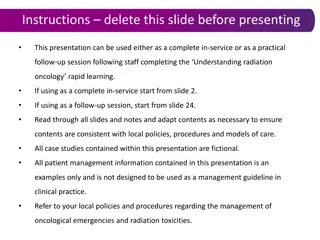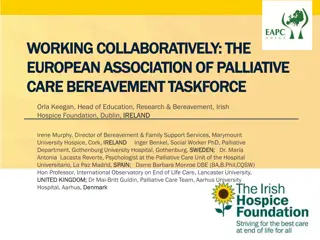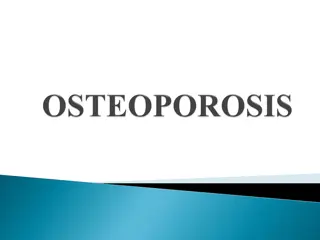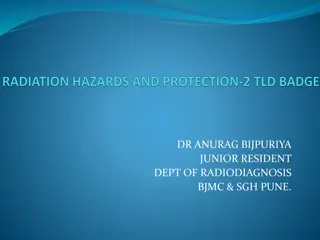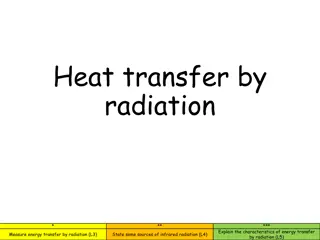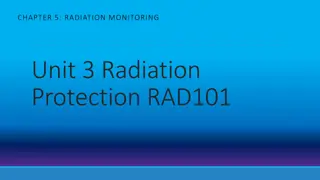ASTRO Clinical Guideline on Palliative Radiation Therapy for Symptomatic Bone Metastases
This ASTRO clinical guideline focuses on the use of external beam radiation therapy for palliation of symptomatic bone metastases, emphasizing its efficacy in pain management and local symptom control. Updated evidence and recommendations address the evolving landscape of metastatic cancer treatments. The multidisciplinary task force highlights the importance of a team-based approach, including radiation, medical, and surgical oncologists, palliative care specialists, and patient representatives. The guideline strives to optimize care for patients with bone metastases by integrating modern advancements in radiation therapy with systemic treatments.
Download Presentation

Please find below an Image/Link to download the presentation.
The content on the website is provided AS IS for your information and personal use only. It may not be sold, licensed, or shared on other websites without obtaining consent from the author. Download presentation by click this link. If you encounter any issues during the download, it is possible that the publisher has removed the file from their server.
E N D
Presentation Transcript
External Beam Radiation Therapy for Palliation of Symptomatic Bone Metastases: An ASTRO Clinical Practice Guideline Developed in collaboration with the American Society of Clinical Oncology and the Musculoskeletal Tumor Society Endorsed by the Canadian Society of Radiation Oncology, European Society for Radiotherapy and Oncology, the Royal Australian and New Zealand College of Radiologists, and Musculoskeletal Tumor Society
Citation This slide set is adapted from the External Beam Radiation Therapy for Palliation of Symptomatic Bone Metastases Guideline to be published in the Sept/Oct 2024 issue of Practical Radiation Oncology (PRO) Web posted link: https://doi.org/10.1016/j.prro.2024.04.018 The full-text guideline is also available on the ASTRO website: www.astro.org
Guideline Task Force Chairs Tracy Balboni, MD, MPH Sara Alcorn, MD, PhD Members ngel Artal Cort s, MD, PhD Margaret Brennan, MD Kristopher Dennis, MD, PhD Dayssy A. Diaz, MD Yee-Cheen Doung, MD Shekinah Elmore, MD Lauren Hertan, MD Candice Johnstone, MD Joshua Jones, MD Nicole Larrier, MD Simon S. Lo, MB, ChB Quynh-Nhu Nguyen, MD Yolanda D. Tseng, MD Divya Yerramilli, MD Sandra Zaky, MD
Task Force Composition Multidisciplinary team of academic and community-based radiation, medical, and surgical oncologists, palliative care specialists, and a member of the Guidelines Subcommittee Related societies American Society of Clinical Oncology (ASCO)* Musculoskeletal Tumor Society (MSTS)* Patient representative *Representatives nominated by specialty societies.
Introduction to Guideline External beam radiation therapy (RT) is an integral component in the management of symptomatic bone metastases, given its effectiveness in reducing pain and other local sequelae of metastatic bone disease. Improvements in systemic therapies resulting in longer life expectancy for many metastatic cancer diagnoses concurrent with technological advancements such as highly-conformal RT have raised questions regarding the efficacy of more conventional forms of palliative RT in a modern population. ASTRO s guideline on patients with symptomatic bone metastases treated with palliative RT was originally published in 2017. This update was needed given continued evolution of the research informing the management of symptomatic bone metastases, and the need for the guideline to reflect that evolution.
Guideline Scope The scope of this guideline is to provide updated evidence on clinical recommendations regarding dose-fractionation and RT delivery techniques in the up front and reirradiation settings; compares RT in conjunction with additional therapies (e.g., bisphosphonates, surgery, vertebroplasty) with RT alone; and if and how effectiveness and harms of RT vary by patient and clinical characteristics, with the aim of determining if certain subsets of patients may benefit from specific palliative RT regimens and advanced techniques.
Guideline Scope Health Disparities No studies captured a large, diverse cohort with detailed report of race, ethnicity, comorbidities, and social determinants of health. This hindered our ability to evaluate QoL relative to factors known to be associated with health disparities. Evaluated studies may not represent global patterns of delivery of palliative RT. No studies captured patient-reported outcomes comprehensively, such as psychosocial symptoms, time spent receiving treatment, and financial distress. Future studies should consider these outcomes as primary and secondary endpoints when comparing various dose-fractionation regimens and techniques and should ensure adequate assessment of patient demographics, prognosis, and access to care.
AHRQ Systematic Review Guideline based on Agency for Healthcare Research and Quality (AHRQ) systematic review, commissioned and funded by the Patient-Centered Outcomes Research Institute (PCORI). Search dates: 1985 to January 2023 Population: Adult patients with symptomatic bone metastases Outcomes: Primary: pain (level and duration), skeletal function, relief of spinal cord or cauda equina compression, quality of life Secondary: reirradiation, local recurrence, fracture, use of pain medication, need non-RT pain interventions, overall survival Adverse events: treatment toxicities including fracture rate, reduced mobility, pain flare, fatigue, etc. Inclusions: Symptomatic adults with cancer metastatic to bone who will receive initial or reirradiation for palliation Exclusions: Patients <18 yo, asymptomatic lesions, primary bone tumors 9784 studies identified 7973 abstracts retrieved 84 studies (98 publications) included and abstracted into evidence tables
Rating Strength of Recommendation ASTRO s recommendations are based on evaluation of multiple factors including the quality of evidence (QoE) and panel consensus, which, among other considerations, inform the strength of recommendation. QoE is based on the body of evidence available for a particular key question and includes consideration of number of studies, study design, adequacy of sample sizes, consistency of findings across studies, and generalizability of samples, settings, and treatments. Strength of Recommendation Benefits clearly outweigh risks and burden, or risks and burden clearly outweigh benefits. All or almost all informed people would make the recommended choice. Benefits are finely balanced with risks and burden or appreciable uncertainty exists about the magnitude of benefits and risks. Most informed people would choose the recommended course of action, but a substantial number would not. A shared decision-making approach regarding patient values and preferences is particularly important. Overall QoE Grade Recommendation Wording Definition Any (usually high, moderate, or expert opinion) Recommend/ Should Strong Any (usually moderate, low, or expert opinion) Conditionally Recommend Conditional ASTRO Methodology Manual: https://www.astro.org/ASTRO/media/ASTRO/Patient%20Care%20and%20Research/PDFs/ASTRO_GuidelineMethodology.pdf
Rating Quality of Evidence Overall QoE Grade Type/Quality of Study Evidence Interpretation 2 or more well-conducted and highly generalizable RCTs or meta-analyses of such trials. The true effect is very likely to lie close to the estimate of the effect based on the body of evidence. High 1 well-conducted and highly generalizable RCT or a meta- analysis of such trials OR 2 or more RCTs with some weaknesses of procedure or generalizability OR 2 or more strong observational studies with consistent findings. 1 RCT with some weaknesses of procedure or generalizability OR 1 or more RCTs with serious deficiencies of procedure or generalizability or extremely small sample sizes OR 2 or more observational studies with inconsistent findings, small sample sizes, or other problems that potentially confound interpretation of data. Consensus of the panel based on clinical judgement and experience, due to absence of evidence or limitations in evidence. The true effect is likely to be close to the estimate of the effect based on the body of evidence, but it is possible that it is substantially different. Moderate The true effect may be substantially different from the estimate of the effect. There is a risk that future research may significantly alter the estimate of the effect size or the interpretation of the results. Low Strong consensus ( 90%) of the panel guides the recommendation despite insufficient evidence to discern the true magnitude and direction of the net effect. Further research may better inform the topic. Expert Opinion
Consensus Methodology Modified Delphi approach Task force members rated their level of agreement for each recommendation via consensus survey - 5-point Likert scale from strongly disagree to strongly agree - Consensus defined using pre-specified threshold of 75% ( 90% for expert opinion recommendations) agreement Recommendations for which consensus is not achieved are removed or are revised and resurveyed. Recommendations achieving consensus but edited with substantive changes after the first round are also resurveyed.
KQ 1: What are the appropriate indications for RT in the palliative treatment of bone metastases?
KQ 1: Indications for RT in palliative treatment Strength of Recommendation Quality of Evidence High (Overall pain) ______________ Moderate (Neuropathic pain) KQ1 Recommendations 1. For patients with symptomatic bone metastases, RT is recommended to reduce pain from osseous metastasis. Strong 2. For patients with symptomatic spine bone metastases, including those causing compression of the spinal cord or cauda equina, RT is recommended to improve ambulatory status, sphincter function, and reduce pain. Strong High Implementation remark: Before initiating RT, evaluation for spine stability and surgery are necessary. For patients with symptomatic bone metastases and an anticipated life expectancy of 4 weeks, RT is conditionally recommended to improve quality of life (eg, functional status, mobility). 3. Conditional Low Abbreviations: KQ = key question; RT = external beam radiation therapy.
KQ 2: What is the impact of surgery, radiopharmaceuticals, bisphosphonates, or kyphoplasty/vertebroplasty on indications for RT in palliative treatment of bone metastases?
KQ 2: Impact of surgery, radiopharmaceuticals, bisphosphonates, or kyphoplasty/vertebroplasty on indications for RT in palliative treatment of bone metastases Strength of Recommendation Quality of Evidence KQ2 Recommendations 1. For patients with spine bone metastases causing compression of the spinal cord or cauda equina, surgery with postoperative RT is conditionally recommended over RT alone. 2. For patients who have undergone surgery for non-spine bone metastases or for spine metastases without spinal cord or cauda equina compression, postoperative RT is recommended. 3. For patients with spine bone metastases causing compression of the spinal cord or cauda equina, RT combined with dexamethasone is recommended over RT alone. Abbreviations: KQ = key question; RT = external beam radiation therapy. Conditional Low Strong Low Strong Low
KQ 3: What RT dose- fractionation regimens, dose- constraints, and techniques are appropriate for the initial palliative treatment of bone metastases?
KQ 3: Dose-fractionation, dose-constraints, and techniques for initial palliative treatment of bone metastases Strength of Recommendation Quality of Evidence KQ3 Recommendations 1. For patients with symptomatic bone metastases treated with conventional palliative RT, 800 cGy in 1 fraction, 2000 cGy in 5 fractions, 2400 cGy in 6 fractions, or 3000 cGy in 10 fractions are recommended. 2. In patients with spine bone metastases causing compression of the spinal cord or cauda equina who are not eligible for initial surgical decompression and are treated with conventional palliative RT, 800 cGy in 1 fraction, 1600 cGy in 2 fractions, 2000 cGy in 5 fractions, or 3000 cGy in 10 fractions are recommended. Strong High Strong High Implementation remark: Consider patient and disease factors in dose-fractionation selection (eg, prognosis and radiosensitivity).
KQ 3: Dose-Fractionation, dose-constraints, and techniques for initial palliative treatment of bone metastases (con t) Strength of Recommendation Quality of Evidence KQ3 Recommendations 3. For patients with spine bone metastases causing compression of the spinal cord or cauda equina treated with dose-escalated palliative RT, the use of highly conformal planning and delivery techniques (eg, IMRT) is conditionally recommended. 4. For patients with symptomatic bone metastases treated with SBRT, 1200 to 1600 cGy in 1 fraction (non-spine) and 2400 cGy in 2 fractions (spine) are recommended. Conditional Low Strong Moderate Implementation remark: Other established SBRT dose and fractionation regimens (eg, 3-5 fraction) with similar BEDs may be an option based on patient tumor and normal tissue factors, and physician experience.
KQ 3: Dose-Fractionation, dose-constraints, and techniques for initial palliative treatment of bone metastases (con t) Strength of Recommendation Quality of Evidence KQ3 Recommendations 5. For patients with symptomatic bone metastases with ECOG PS 0-2, receiving no surgical intervention, and absent neurological symptoms, SBRT is conditionally recommended over conventional palliative RT. Conditional Low Implementation remark: Other factors to consider include life expectancy, tumor radiosensitivity, and metastatic disease burden. Abbreviations: ECOG PS = Eastern Cooperative Oncology Group performance status; IMRT = intensity modulated radiation therapy; KQ = key question; RT = external beam radiation therapy; SBRT = stereotactic body radiation therapy.
SBRT Dose Constraints 1 fraction 0.35 cc 1000 cGy 10% of partial spinal cord 1000 cGy 0.03 cc 1400 cGy N/R Organs at Risk Spinal cord* 2 fractions Endpoint N/R Myelopathy Spinal cord PRV/ Thecal sac Cauda equina Max point dose 1700 cGy Max point dose 1700 cGy Max point dose 2600 cGy Max point dose 2000 cGy N/R Myelopathy 0.03 cc 1600 cGy 5 cc 1400 cGy 0.03 cc 1800 cGy 5 cc 1440 cGy 0.03 cc 1600 cGy 5 cc 1190 cGy 0.03 cc 1750 cGy 5 cc 1400 cGy 0.03 cc 2200 cGy 15 cc 1600 cGy 0.03 cc 3700 cGy 10 cc 3100 cGy 0.03 cc 2020 cGy 4 cc 1050 cGy Neuropathy Sacral plexus Plexopathy Esophagus Stenosis/ fistula Ipsilateral brachial plexus Heart/pericardium Plexopathy N/R Pericarditis Great vessels N/R Aneurysm Trachea and larynx Max point dose 2000 cGy Larynx: Mean 900 cGy Stenosis/ fistula
SBRT Dose Constraints (cont) Organs at Risk 1 fraction 2 fractions Endpoint Skin 0.03 cc 2600 cGy 10 cc 2300 cGy N/R Ulceration Stomach 0.03 cc 1600 cGy 10 cc 1120 cGy Max point dose 2000 cGy Ulceration/fistula Duodenum 0.03 cc 1600 cGy 5 cc 1120 cGy Max point dose 2000 cGy Ulceration Jejunum/Ileum 0.03 cc 1540 cGy 5 cc 1190 cGy Max point dose 2000 cGy Enteritis/obstruction Colon 0.03 cc 1840 cGy 20 cc 1430 cGy Max point dose 2000 cGy Colitis/fistula Rectum 0.03 cc 1840 cGy 20 cc 1430 cGy Max point dose 2000 cGy Proctitis/fistula Renal hilum/vascular trunk Lungs (right and left) <2/3 <1060 cGy N/R Malignant hypertension Pneumonitis 1000 cc 740 cGy V10 <10%, V5 <35%, and V20 <3% and a mean dose of 500 cGy for each lung
SBRT Dose Constraints (cont) Organs at Risk 1 fraction 2 fractions Endpoint Renal cortex (right and left) 200 cc 840 cGy Max point dose 2600 cGy Mean dose for each kidney 600 cGy Max point dose 2600 cGy Mean dose 800 cGy Max point dose 2000 cGy Mean 900 cGy Mean dose 700 cGy for each parotid N/R Basic renal function Liver N/R Liver dysfunction Pharynx N/R Stenosis/fistula Parotids N/R Xerostomia Renal hilum/vascular trunk Pharynx <2/3 <1060 cGy Malignant hypertension Stenosis/fistula N/R Max point dose 2000 cGy Mean 900 cGy Mean dose 700 cGy for each parotid N/R Parotids N/R Xerostomia Renal hilum/vascular trunk Abbreviations: Max = maximum; N/R = not reported; PRV = planning organ at risk volume; SBRT = stereotactic body radiation therapy. The partial spinal cord should be contoured starting from 5-6 mm above the superior extent of the target volume to 5-6 mm below the inferior extent of the target volume; greater spinal cord volume should be contoured to well-encompass cord dose from beams (eg, noncoplanar beams). Avoid circumferential irradiation. Note: Constraints included are based on trial protocols. See text for discussion about additional sources for dose constraints available for SBRT. <2/3 <1060 cGy Malignant hypertension
KQ 4: What palliative RT dose- fractionation regimens, dose- constraints, and techniques are appropriate for palliative reirradiation of bone metastases?
KQ 4: Dose-fractionation, dose-constraints, and techniques for palliative reirradiation Strength of Recommendation Quality of Evidence KQ4 Recommendations 1. For patients with spine bone metastases that would benefit from reirradiation to the same site, conventional palliative RT regimens of 800 cGy in 1 fraction, 2000 cGy in 5 fractions, 2400 cGy in 6 fractions, or 2000 cGy in 8 fractions are recommended. Strong Moderate Implementation remark: Consider prior RT dose, time interval, and total spinal cord tolerance when determining RT dose-fractionation. Abbreviations: KQ = key question; RT = external beam radiation therapy; SBRT = stereotactic body radiation therapy.
KQ 4: Dose-fractionation, dose-constraints, and techniques for palliative reirradiation (con t) Strength of Recommendation Quality of Evidence KQ4 Recommendations 2. For patients with spine bone metastases that would benefit from reirradiation to the same site, treatment with SBRTis conditionally recommended. Implementation remarks: Consider patient factors (eg, urgency of treatment, prognosis, and radio-resistance) when determining if SBRT is indicated. Consider prior RT dose, time interval, and total spinal cord tolerance when determining RT dose-fractionation. 3. For patients with symptomatic non-spine bone metastases that would benefit from reirradiation to the same site, single- fraction (800 cGy in 1 fraction) or multifraction conventional palliative RT (2000 cGy in 5 fractions or 2400 cGy in 6 fractions) are recommended. Expert Opinion Conditional Strong Moderate
Spinal Cord Reirradiation Considerations for Spine SBRT Prior Radiation Details SBRT Reirradiation Dose Recommendations Prior spinal cord total dose Planned # of fractions Acceptable range of reirradiation total dose Recommended thecal sac constraint (Dmax) Prior EQD2-2 2000 cGy/5 fx - 3000 cGy/10 fx 4000 cGy/20 fx - 5000 cGy/25 fx 2000 cGy/5 fx - 4500 cGy/25 fx 5000 cGy/25 fx 2000 cGy/5 fx - 4500 cGy/25 fx 5000 cGy/25 fx 3000 - 3750 cGy 1 1600 - 1800 cGy 900 cGy 4000 - 5000 cGy 1 Not recommended Not recommended 3000 - 4300 cGy 2 1600 - 2400 cGy 1220 cGy 5000 cGy 3000 - 4300 cGy 2 3 1600 - 2000 cGy 1800 - 2700 cGy 1100 cGy 1450 cGy 5000 cGy 3 1500 - 2400 cGy 1250 cGy
Spinal Cord Reirradiation Considerations for Spine SBRT (con t) Prior Radiation Details SBRT Reirradiation Dose Recommendations Prior spinal cord total dose Planned # of fractions Acceptable range of reirradiation total dose Recommended thecal sac constraint (Dmax) Prior EQD2-2 2000 cGy/5 fx - 4500 cGy/25 fx 5000 cGy/25 fx 2000 cGy/5 - 4500/25 fx 3000 - 4300 cGy 3000 - 4300 cGy 4 2400 - 3000 cGy 1620 cGy 5000 cGy 4 5 2000 - 2600 cGy 2500 - 3000 cGy 1400 cGy 1800 cGy 5000 cGy/25 fx 5000 cGy 5 2000 - 2500 cGy 1550 cGy Abbreviations: Dmax = maximum point dose to an organ or tumor target; EQD2-2= dose calculation to an equivalent dose of 2 Gy with an -to- ratio of 2; SBRT = stereotactic body radiation therapy. Adapted with permission from Sahgal, et al.
KQ 5: How do the different dose-fractionation regimens and techniques impact on treatment toxicity and QoL?
KQ 5: Impact of dose-fractionation and techniques on toxicity and QoL Strength of Recommendation Quality of Evidence KQ5 Recommendations 1. For patients with bone metastases receiving palliative RT, a shared decision-making approach is recommended to determine dose, fractionation, and use of supportive measures to optimize QoL. Expert Opinion Strong Abbreviations: KQ = key question; RT = external beam radiation therapy; QoL = quality of life.
Figure. RT for symptomatic bone metastases *Algorithm applies to all symptomatic bone metastases either in the setting of no prior RT or after a prior course of RT (ie, reirradiation). Further details pertinent to symptomatic bone metastases in the setting of reirradiation are found in the KQ4 recommendations. Patients with metastatic spinal cord or cauda equina compression should receive dexamethasone as part of their up-front management. RT = Selection of treatment dose intensity and planning modality (eg, conventional palliative RT vs SBRT) are discussed in the recommendations section. Abbreviations: KQ = key question; RT = external beam radiation therapy; SBRT = stereotactic body radiation therapy.
Key Takeaways Palliative RT has a central role in management of symptomatic bone metastases. Surgery followed by RT is often indicated for patients with bone metastases complicated by spinal cord or cauda equina compression and/or by bone instability. Standard conventional palliative RT regimens include 800 cGy in 1 fraction, 2000 cGy in 5 fractions, 2400 cGy in 6 fractions, and 3000 cGy in 10 fractions. Stereotactic body radiation therapy is indicated for improving pain control and local control in selected patients with symptomatic bone metastases, with tested regimens including 1200-1600 cGy in 1 fraction and 2400 cGy in 2 fractions.
Key Takeaways Reirradiation with palliative RT is indicated for patients with symptomatic bone metastases in previously treated bone. Reirradiation regimens include: 800 cGy in 1 fraction, 2000 cGy in 5 fractions, 2400 cGy in 6 fractions, and 2000 cGy in 8 fractions. Dose- fractionation selection depends on factors such as prior RT, normal tissues at risk, and time interval. Stereotactic body radiation therapy for retreatment of spine metastases is indicated in selected patients, with meticulous selection of patients and of retreatment dosing based on normal tissue tolerances. To optimize quality of life and patient-centered care, shared-decision making with patients is needed. Further research required to optimize symptomatic bone metastases management and to improve patient-centered care and quality of life.



